Venezuelan authorities are committing widespread human rights violations against protesters, bystanders, opposition leaders, and critics following the July 28, 2024, presidential election, Human Rights Watch said today. Concerned governments should push for independent verification of the electoral results and support international efforts to ensure accountability.
International observers have raised serious concerns about the July 29 announcement by Venezuela's National Electoral Council (CNE) that Nicolás Maduro had been re-elected president. Following the announcement, thousands of protesters have taken to the streets, in largely peaceful protests, to demand a fair counting of the votes. Human Rights Watch has documented that Venezuelan authorities and pro-government armed groups known as "colectivos" have committed widespread abuses, including killings, arbitrary detention and prosecution, and harassment of critics. On September 2, a judge issued an arrest warrant against opposition candidate Edmundo González for "conspiracy," "incitement to disobedience" and other crimes.
"The repression we are seeing in Venezuela is shockingly brutal," said Juanita Goebertus, Americas director at Human Rights Watch. "Concerned governments need to take urgent steps to ensure that people are able to peacefully protest and that their vote is respected."
Venezuelans voted in the presidential election in large numbers, despite irregular government actions and human rights violations in the lead-up to the election, including arrests of opposition members, arbitrary disqualifications of opposition candidates, and restrictions on Venezuelans voting abroad. Several hours after polls closed, Venezuela's electoral council declared that Maduro had won the election with over 51 percent of the vote. The Electoral Council has not released the tally sheets from the election, nor conducted the audits and citizen verification processes required by law.
The United Nations Electoral Technical Team and the Carter Center, which observed the elections, said the process lacked transparency and integrity, and questioned the declared result. They indicated that, instead, the precinct-level tally sheets that the opposition made public were reliable. The Carter Center noted that the tally sheets showed, with 81 percent of the votes counted, that González had won the election by a significant margin.
Venezuelans have taken to the streets across the country, particularly in low-income areas traditionally supportive of the Chavismo movement, where many incidents of repression have taken place.
Human Rights Watch received credible reports of 24 killings in the context of protests from independent local groups, including Foro Penal, Justicia Encuentro y Perdón, Monitor de Víctimas, and Provea, or discovered them on social media. Human Rights Watch independently documented 11 of these cases, including by reviewing death certificates, verifying videos and photographs, and interviewing 20 people, including witnesses and other local sources. Many relatives, witnesses, and others were not willing to be interviewed because they feared government retaliation.
Human Rights Watch analyzed and verified 39 videos and 2 photographs of protests found on social media platforms or sent directly to researchers by people close to the victims, and by local organizations and journalists. Researchers confirmed the exact locations where these videos were filmed; used information such as shadows, weather patterns, and upload dates to determine the time of day; and consulted with forensic pathologists and arms experts, who analyzed the injuries and weapons that were seen and heard.
According to Venezuelan authorities, they arrested over 2,400 people in connection with protests. The local pro bono group Foro Penal recorded over 1,580 "political prisoners" who have been arrested since July 29, including 114 children. Prosecutors have charged hundreds with sometimes broadly defined crimes carrying harsh sentences, such as "incitement to hatred," "resistance to authority," and "terrorism."
The government has also intensified its broader repressive tactics, cancelling passports of critics to prevent them from leaving the country, encouraging citizens to report on demonstrators, and conducting abusive raids, especially in low-income communities. On August 15, Maduro's supporters in the National Assembly passed a law that grants the government broad powers to control and shut down nongovernmental organizations.
The governments of Colombia, Brazil, and Mexico have called for talks with the Venezuelan government. On August 16, the Permanent Council of the Organization of American States, where all member states are represented, approved by consensus a resolution urging Venezuelan authorities to publish the precinct-level tally sheets and carry out an "impartial verification" of the results. It also urged authorities to respect human rights.
The European Union, the US, and several Latin American and European governments have also urged Maduro to release and respect the electoral results and guarantee the rights of opposition leaders, protesters, and critics.
The prosecutor of the International Criminal Court (ICC), Karim Khan, who is investigating crimes against humanity in the country, has said that his office is actively monitoring the situation.
Governments should support efforts to ensure accountability for grave violations in Venezuela, including by renewing the mandate of the Independent International Fact-Finding Mission on Venezuela (FFM) during the upcoming United Nations Human Rights Council session, Human Rights Watch said. They should also support the ongoing investigation of the Office of the Prosecutor of the ICC and consider imposing targeted sanctions on those responsible for grave violations.
For detailed recommendations and information on Human Rights Watch findings on post-electoral government repression, please see below.
Recommendations
Foreign governments should take urgent steps to promote accountability and ensure respect for the electoral results. These include:
- Continue to publicly and privately call on Maduro to end human rights violations, including repression of protesters, publish the precinct-level tally sheets, allow for an independent verification of the electoral results, and respect the will of the Venezuelan people as expressed in the polls on July 28.
- Work multilaterally to explore rights-respecting ways to encourage Maduro's international allies, including Cuba, and the oil industry in Venezuela to call on Maduro to publish the tally-sheets, to provide for an independent process of verification of the electoral results, and to respect people's vote.
- Renew the mandate of the FFM, which remains key to push for accountability for widespread violations, during the upcoming session of the United Nations Human Rights Council.
- Impose targeted sanctions on members of the security forces, "colectivos," judges and prosecutors responsible for grave human rights violations.
- Expand access to asylum and other forms of international protection for Venezuelans leaving their country in line with international standards.
- Support the ongoing investigation of the Office of the Prosecutor of the International Criminal Court into crimes against humanity in Venezuela, and ensure that the court has the resources it needs to support work across its docket.
Killings During Protests
Human Rights Watch received credible allegations that twenty-three protesters or bystanders, as well as one member of the Bolivarian National Guard (Guardia Nacional Bolivariana, GNB) security force were killed during protests, most on July 29 and 30, as the protests peaked.
Eight cases were reported in Caracas District, particularly in the low-income neighborhoods of El Valle and Antímano. Six occurred during the same protests in San Jacinto, Maracay, Aragua state. The remaining cases occurred in Bolívar, Carabobo, Lara, Miranda, Táchira, Yaracuy, and Zulia states.
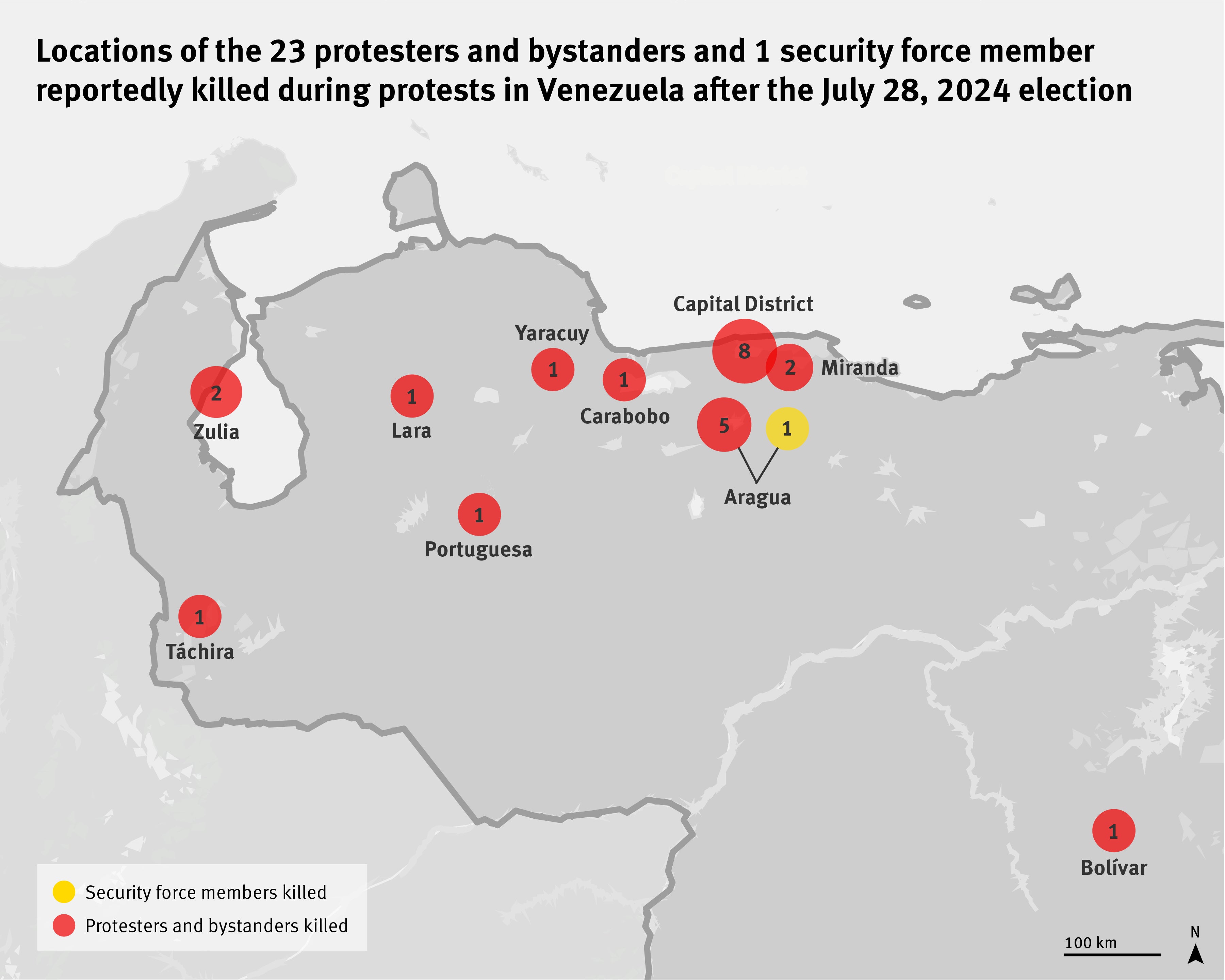
Credible evidence gathered by Human Rights Watch implicates security forces, including the GNB and the police (Policía Nacional Bolivariana, PNB) in some killings.
In other cases, pro-government, armed "colectivo" groups appear to be responsible. "Colectivos" have for years intimidated and harassed critics and informed on them to the government, especially in low-income neighborhoods. In 2020, the FFM found that during past protests "colectivos were in some cases involved in crowd control or violations in coordination with the state armed forces and/or upon the instruction of state political leaders."
Witnesses, journalists, and human rights groups who investigated the recent protests described to Human Rights Watch how security forces and pro-government groups clamped down on protesters. Initially, security forces controlled or dispersed demonstrations, often using barricades, throwing tear gas, and arresting protesters. If the demonstrations continued, members of "colectivos" showed up, often using firearms to intimidate or attack protesters.
In one apparent example of coordination between apparent "colectivo" members and security forces, Human Rights Watch verified a video posted on TikTok on July 29 at 5:59 p.m. local time, in which at least three men in civilian clothes are firing handguns in the air close to fleeing protesters from behind a line of uniformed security forces making the protesters disperse. They shoot their weapons for over a minute. The security forces take no steps to stop or arrest them. Human Rights Watch geolocated the video to have been recorded on Urdaneta Avenue in Caracas.
Isaías Jacob Fuenmayor González (Zulia State, July 29)
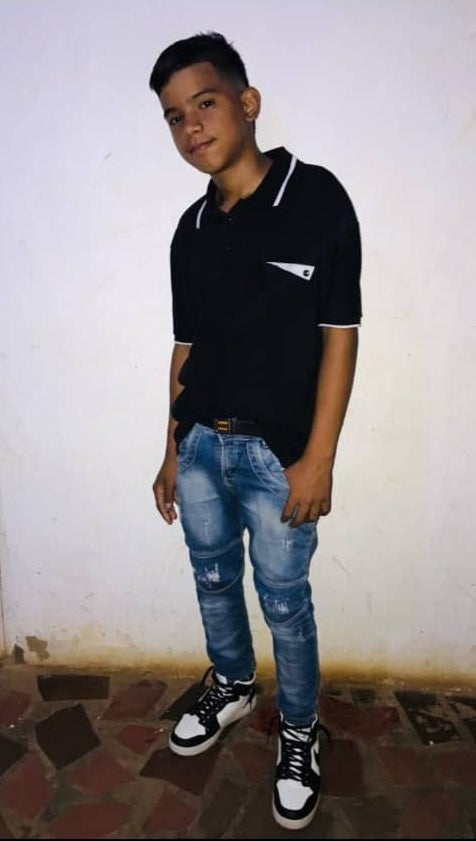
Isaías Jacob Fuenmayor González, 15, left his home in San Francisco, Zulia state, on the late morning of July 29 to practice a dance with his friends for an upcoming 15th birthday party, his sister told Human Rights Watch. On his way home, she said, Fuenmayor González joined friends who were participating in a demonstration near the Mathías Lossada high school, which had served as a polling place. A video sent to researchers and verified by Human Rights Watch shows Fuenmayor González walking among protesters, midway from the rehearsal site and his home. The video was filmed late into the day as the light is fading to the west.
A journalist who was present told Human Rights Watch that National Guard members on motorbikes repeatedly rode into the crowd to try to disperse the protest at different times during that afternoon. Human Rights Watch verified two videos that, in line with the journalist's report, show GNB members using their motorbikes to disperse protesters. By analyzing shadows, Human Rights Watch found that one of the videos, posted on X at 6:35 p.m., was recorded around 4:10 p.m. The journalist also said that some protesters threw rocks at the local office of the ruling United Socialist Party of Venezuela (Partido Socialista Unido de Venezuela, PSUV), located in front of the high school.
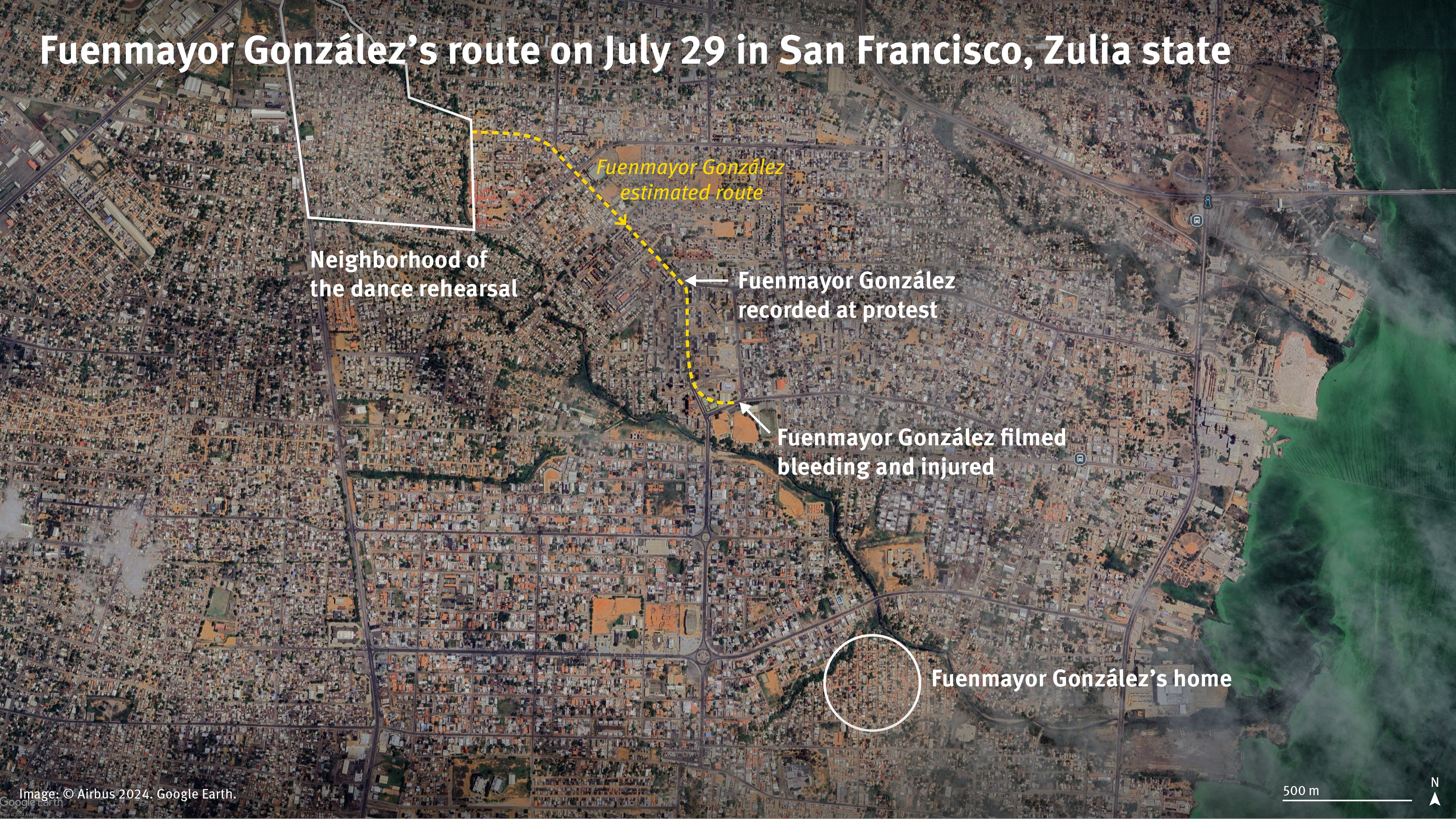
The journalist, local media, and human rights groups say that members of "colectivos" attacked protesters after the National Guard's initial clash with demonstrators. Some time after 7:30 p.m., a bullet hit Fuenmayor González in the neck. Two videos filmed at night, which Human Rights Watch verified and geolocated to a corner of the Mathías Lossada high school, in front of the PSUV local office, show a boy carrying a clearly injured Fuenmayor González to a motorcycle.
He was taken on the motorcycle to the nearby Doctor Manuel Noriega Trigo hospital, where he died. His death certificate, which Human Rights Watch reviewed, indicates that he died due to blood loss caused by a gunshot wound to his neck.
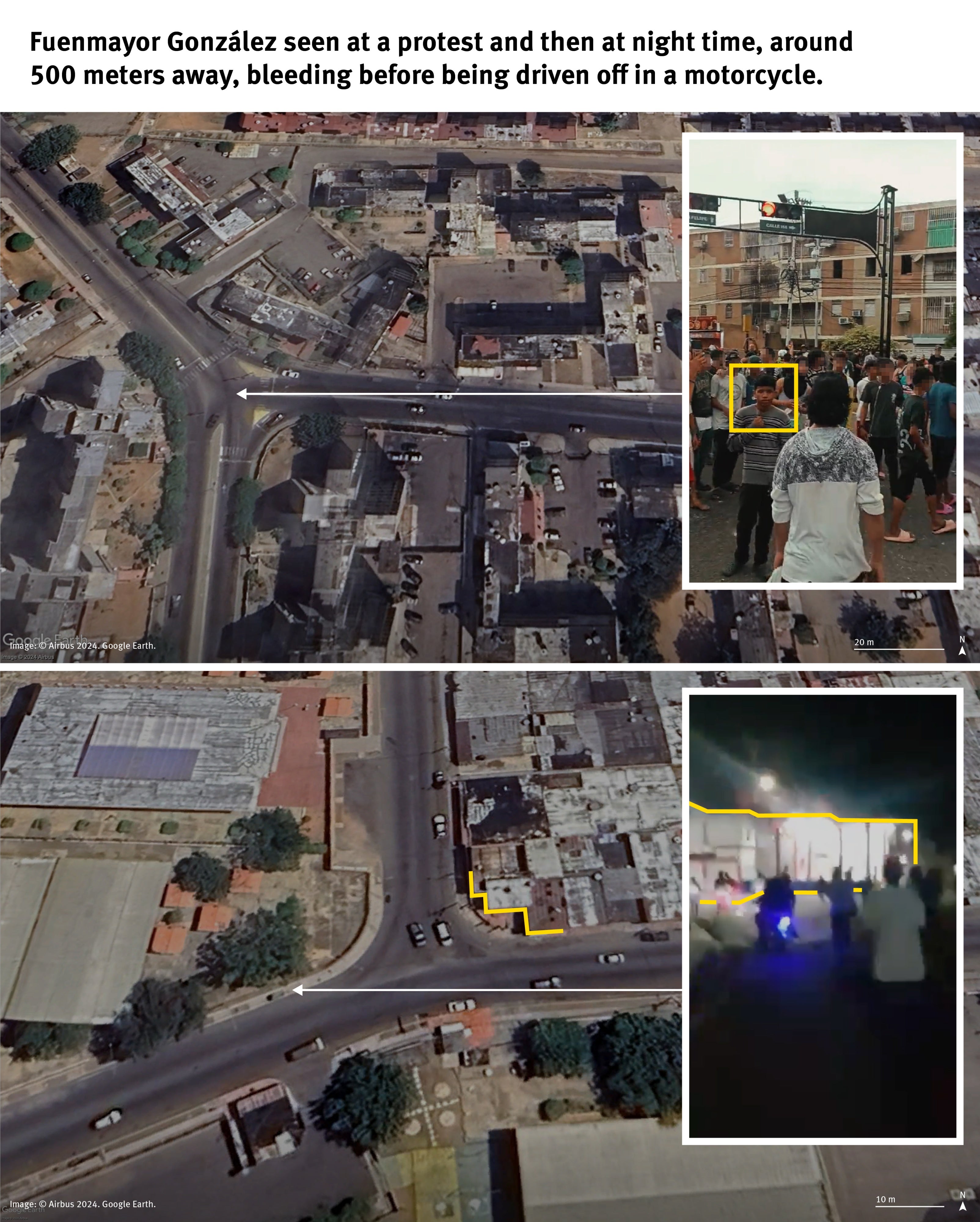
"I want justice for my brother," Fuenmayor González's sister told Human Rights Watch. "He was a child who did not deserve to die, a child who was just beginning to live."
Anthony Enrique García Cañizalez and Olinger Johan Montaño López (Caracas District, July 29)
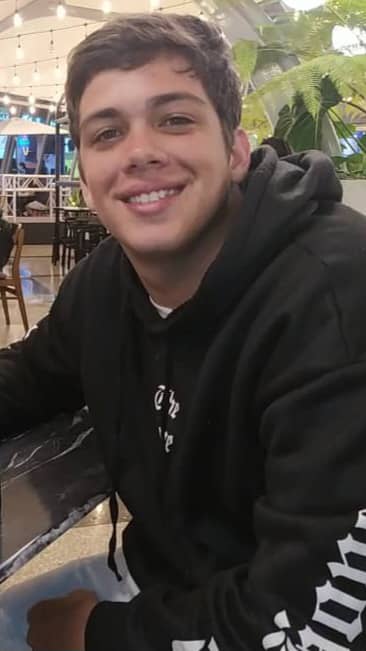
On the afternoon of July 29, Anthony Enrique García Cañizalez, a 20-year-old student, left his home in El Valle, Caracas district, to bring food to a family member in the Supreme Commander Hugo Chávez Maternity Hospital, his aunt told Human Rights Watch. As he was returning home, García Cañizalez encountered a protest near the Abigail González school, which had served as a polling place.
Olinger Johan Montaño López, 23, a barber from El Valle, took part in the protest by the Simoncito Libertador school, according to a Facebook video geolocated by Human Rights Watch, approximately 750 meters northeast of the Abigail González school. Montaño López was passionate about music and sang and wrote his own songs under the artistic name "Saffary," according to his posts on social media. "It is better to die in battle than to die in misery," Montaño López posted on his social media that day.
Human Rights Watch verified three videos northeast of the Abigail González school, around Bolívar square, that show National Guard members dispersing the protest, including by throwing tear gas or smoke canisters, and shooting kinetic impact projectiles from riot guns. In one of the videos, filmed at night, a person identifying themselves as a journalist, says that it is 7:32 p.m., which is consistent with nighttime beginning at 7:14 p.m. that day. Protesters are seen throwing what appear to be rocks at security officers, as the security officers throw what appear to be tear gas or smoke grenades, and fire unidentified types of weapons in another direction off camera.
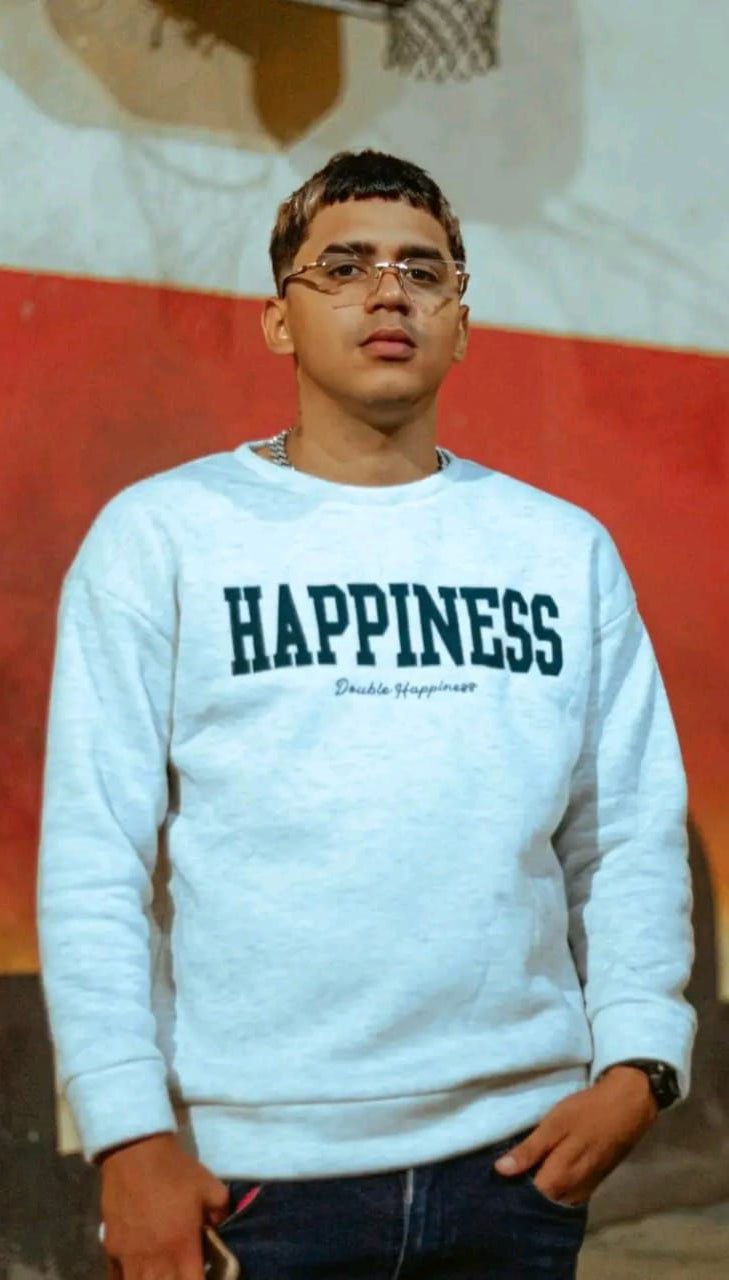
Two videos geolocated by Human Rights Watch just two hundred meters northwest from the Abigail González school, filmed at night, show a group of people carrying an injured person, whom Human Rights Watch identified as Montaño López, and a group of people around another injured person on the road nearby. A video shared on social media platforms shows a shirtless man covered in blood as a group of people pick him up. García Cañizalez's aunt identified the man as her nephew. Human Rights Watch geolocated the video having been filmed in the same location as the other two videos.
García Cañizalez's aunt told researchers he was shot at around 8:30 p.m. on his way home, 400 meters away. Montaño López had stopped replying to messages around 8:40 p.m., a source said.
García Cañizalez died that day at the Coche Hospital. His death certificate, reviewed by Human Rights Watch, states that he was killed by massive internal hemorrhaging caused by gunshot wounds. "He was a young boy, with a zest for life, which was taken away from him," his aunt said.
Montaño López was also taken to the Coche Hospital, where he died. His death certificate, which Human Rights Watch reviewed, says he died due to a penetrating thoracic trauma caused by a firearm.
Aníbal José Romero Salazar (Caracas District, July 29)
On July 29, Aníbal José Romero Salazar, a 24-year-old construction worker known by his friends as "Pimpina," took part in a protest in Carapita, a low-income neighborhood in Antímano, Caracas.
Human Rights Watch verified two videos filmed in quick succession posted on X at 4:43 p.m. and 4:53 p.m. These show protesters on Intercommunal Avenue, 300 meters southwest of the Carapita Metro station, peacefully chanting and banging pots, while passing motorbikes honk their horns. In one video, a group of men are standing on a bus stop and a nearby structure.
Using weather data, Human Rights Watch confirmed that the videos were filmed after 2:30 p.m. and before they were posted. A third video posted on TikTok at 5:31 p.m. on July 29 shows hundreds of protesters by a nearby pedestrian bridge filmed that afternoon. Dozens of protesters can be seen throwing objects at several police officers in dark uniforms and others with yellow vests who are shielding themselves and running away. Other officers appear to be firing their weapons at protesters.
Around 7 p.m., a bullet hit Romero Salazar on the right side of his forehead. A photograph posted on X at 7:45 p.m. on July 29 and reviewed by Human Rights Watch shows this wound. He was about 230 meters from the protesters on Intercommunal Avenue. Human Rights Watch reviewed an audio message sent by a witness to a local human rights organization.
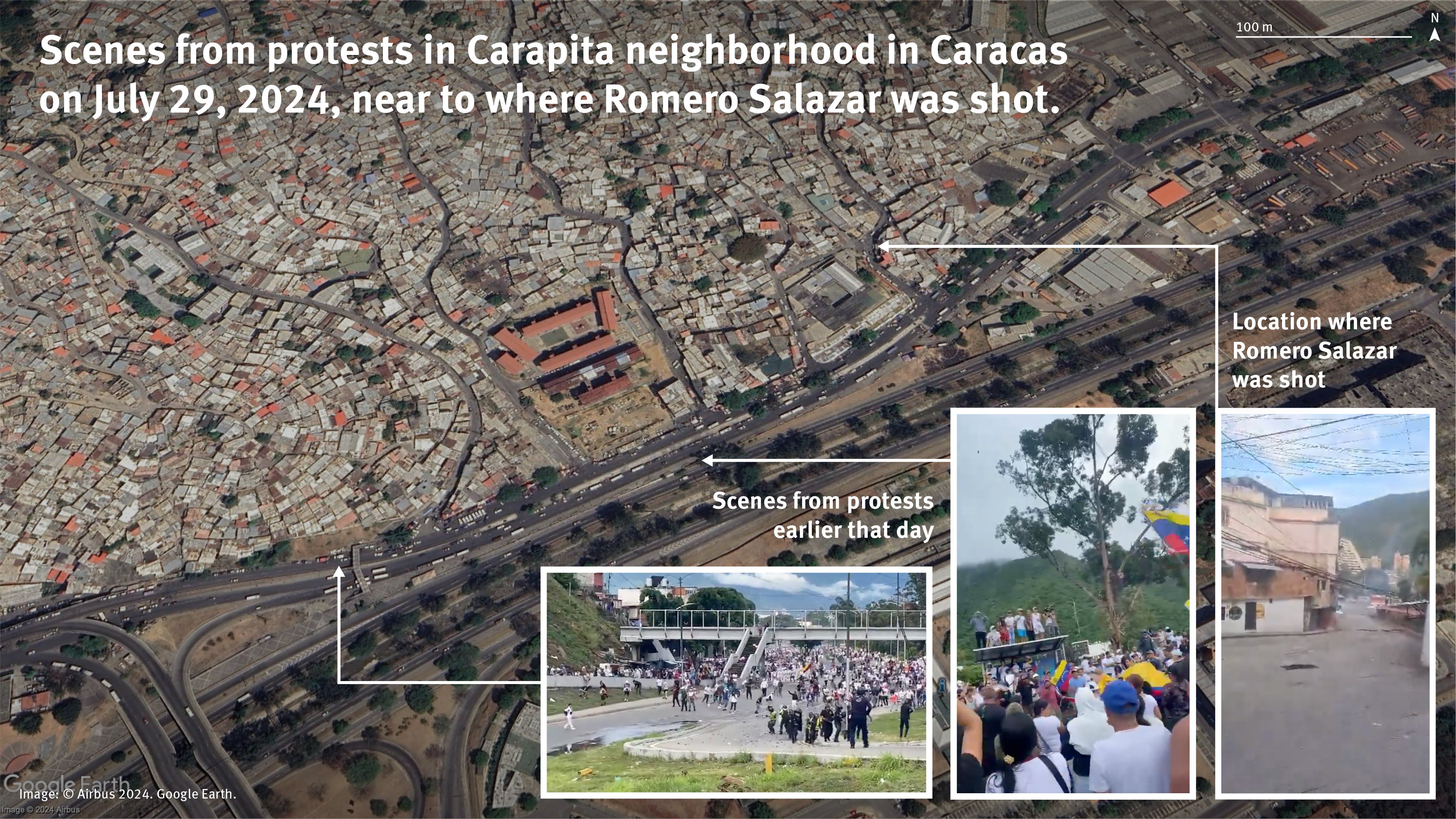
The witness, who said he was at the protest with Romero Salazar, said that when Romero Salazar was injured, police officers from the Directorate of Strategic and Tactical Actions (Dirección de Acciones Estratégicas y Tácticas, DAET) were shooting firearms at protesters near a local church. A video uploaded to TikTok and taken approximately 100 meters south from where Romero Salazar was shot, shows an armed person wearing dark clothing with white letters on his back, consistent with DAET uniforms.
A video posted on YouTube on August 2 filmed from a nearby building, which Human Rights Watch verified, shows the 21 seconds before Romero Salazar was shot and some seconds following. Romero Salazar is outside the church with a group of protesters, holding what appears to be a homemade shield. A gunshot is heard, and Romero Salazar falls. Another video filmed in the same location, which was shared on X at 7:35 p.m. on July 29, shows protesters carrying a wounded Romero Salazar.
The witness, whose audio Human Rights Watch reviewed, said that police officers did not allow protesters to take Romero Salazar to the hospital. A video filmed after dark shows Romero Salazar lying wounded in the back of a truck that is not moving. Eventually protesters were able to take him to the nearby Pérez Carreño hospital, where he died.
During a news conference on July 31, Maduro showed a social media post that referred to Romero Salazar's death and said it was "fake news." Maduro claimed that Romero Salazar had confessed that his death had been faked, and as proof, he showed a video of a man stating that his own death was simulated.
However, Human Rights Watch has been able to establish that Maduro's claim that Romero Salazar was not dead is demonstrably false; the name used by the man in the video Maduro showed, and the location at which he claimed the incident happened, did not match Romero Salazar's case. A local organization that assisted Romero Salazar's family also confirmed that the person in the video Maduro showed is not Romero Salazar.
Rancés Daniel Yzarra Bolívar (Aragua state, July 29).
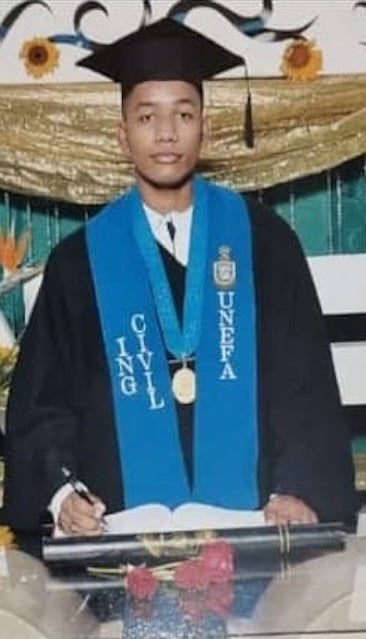
Rancés Daniel Yzarra Bolívar, a 30-year-old civil engineer who worked in a food truck, took part in protests in the San Jacinto neighborhood, in Maracay, Aragua state, on July 29. He lived in a social housing complex that had recurring power outages. A person close to Yzarra Bolívar, said that he had been hopeful about the elections and participated in the protests because of a "frustration with the lack of change."
That morning, people in San Jacinto banged pots and pans from their homes, protesting a power outage and the announced electoral result. At around 2:30 p.m., protesters took to the streets marching toward the Maracay obelisk, 200 meters from the 42nd Parachute Infantry Brigade's compound. A journalist who covered the demonstration told Human Rights Watch that it was initially peaceful, with demonstrators singing the Venezuelan national anthem and chanting.
People approached the military compound and called for soldiers to come out and join the protest, a witness said. A soldier asked them to leave. Some left but others stayed. About half an hour later, the National Guard arrived. A video uploaded to Instagram by a journalist and verified by Human Rights Watch shows officers arriving at about 5 p.m.
In the video, officers equipped with riot gear on motorcycles, accompanied by a riot control vehicle, advance down Avenue 2 Oeste and form a blockade in front of the military compound. Protesters, some on motorcycles and others on foot, are seen chanting "freedom, freedom," peacefully, close to the entrance. Four other videos Human Rights Watch analyzed show people peacefully protesting near the entrance.
A six-minute video posted on Instagram almost half-an-hour later by a journalist and analyzed by Human Rights Watch shows a cloud of smoke coming from two locations in the vicinity of the military compound. A voice off-camera says it is 5:37 p.m. and that National Guard officers are using tear gas to disperse protesters. Human Rights Watch geolocated the video to be approximately 150 meters from the compound.
A journalist told Human Rights Watch that after the National Guard violently attempted to disperse protesters, some threw rocks and burned police motorcycles in retaliation. In one verified video, protesters are seen throwing Molotov cocktails in the direction of the military compound.
At approximately 6 p.m., a bullet hit Yzarra Bolívar on the left side of his chest, a person close to him said. Human Rights Watch analyzed and geolocated four videos showing Yzarra Bolívar injured and unconscious. In one verified video, taken by a journalist at 5:50 p.m. and posted 20 minutes later, two protesters are seen carrying Yzarra Bolívar to a location approximately 150 meters from the military compound. Other protesters are heard shouting "they killed him."
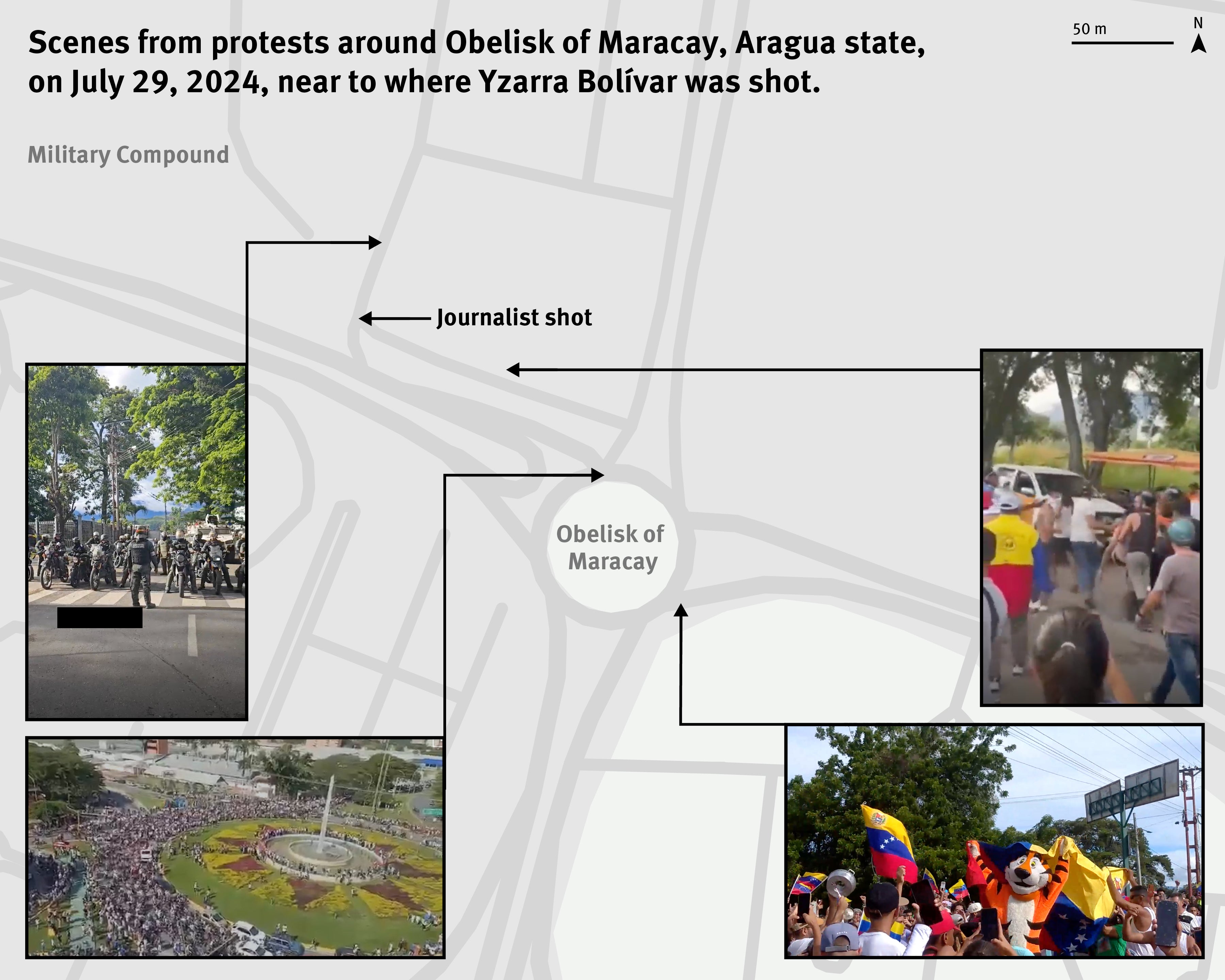
The video subsequently shows three other protesters carrying him to the back of a white van, which drives away. Yzarra Bolívar's death certificate, which Human Rights Watch reviewed, says that he died of acute hemorrhagic shock due to the perforation of his thoracic organs.
Human Rights Watch received credible reports that five other people died from injuries inflicted during same protest. These are: Jesús Gregorio Tovar Perdomo, Anthony David Moya Mantía, Jesús Ramón Medina Perdomo, Gabriel Ramos, and the National Guard officer José Antonio Torrents Blanca. Local human rights groups who documented the cases said that they all died from firearm wounds.
The Independent Forensic Expert Group (IFEG) of the International Rehabilitation Council for Torture Victims (IRCT) consulted by Human Rights Watch reviewed a video of Tovar Perdomo's wound, and concluded that it was caused either by a high-velocity gunshot or a gunshot at close range.
The National Survey of Hospitals, a group of healthcare workers that monitors health issues in Venezuela, reported that about 50 people injured in protests arrived at 3 hospitals in Maracay between July 29 and August 1. Human Rights Watch analyzed and geolocated four videos in which eight people can be seen bleeding from injuries or being carried by protesters. Some of the patients injured or killed had firearm wounds, the group said.
Two people close to the victims, and a witness present during the protest said that many protesters were wounded by shots coming from inside the military compound.
Human Rights Watch verified a video recorded by a local journalist who was shot in his stomach and right leg during the protests. In the video, recorded in front of the building, facing the entrance, three gunshots are heard. The camera angles then become disoriented, and background sounds suggest that the journalist has been injured. The journalist told Human Rights Watch the video was filmed at approximately 5:30 p.m.
Yorgenis Emiliano Leyva Méndez (Miranda State, July 30)
On July 30, Yorgenis Emiliano Leyva Méndez, 35, participated in protests by motorcyclists against the electoral results in Ambrosio Plaza, Miranda state. The previous day, a group of at least three unidentified men threw a Molotov cocktail in the city's main square, Plaza Bolívar. Human Rights Watch analyzed and geolocated a video of the incident.
The July 30 protest in Guarenas was largely peaceful, a media worker who covered the protest told Human Rights Watch. "The most violent thing I saw was people tearing down electoral propaganda from Maduro and burning it," they said. Human Rights Watch verified a video of the protest taken at 4 p.m., according to its caption, and posted an hour later on Instagram.
The video shows a group of people chanting peacefully and carrying flags on the Intercommunal Avenue Guarenas-Guaitare, 7.5 kilometers from Plaza Bolívar. Later, the protest moved toward Guarenas, the media worker said. Witnesses said, and a video reviewed by Human Rights Watch showed that at around 5:50 p.m. a group of people on motorbikes yelling and blaring their horns were protesting around Plaza Bolívar. In the video Leyva Méndez is seen on a motorcycle among the group.
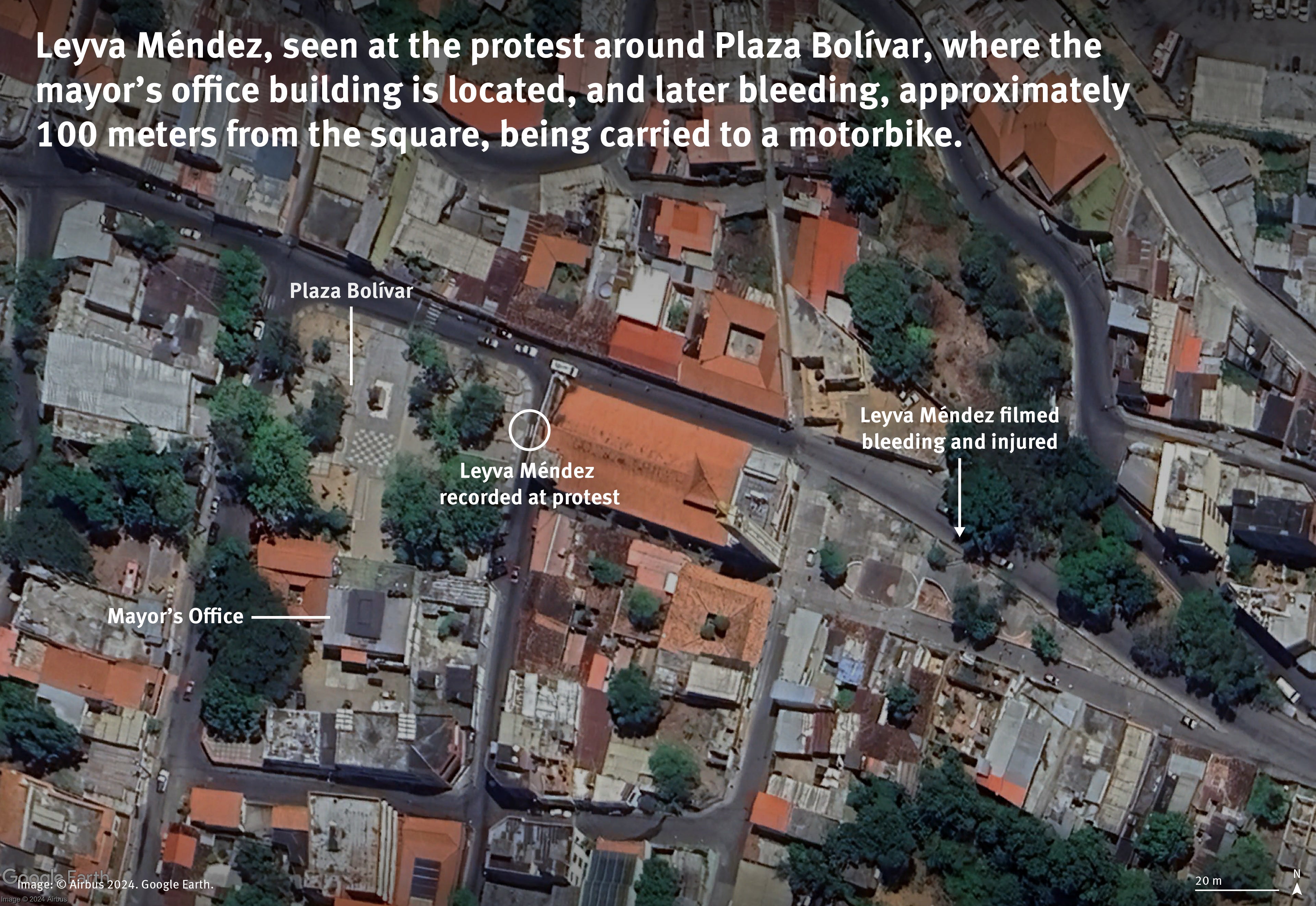
The square was guarded by municipal police and armed men whom local people described as belonging to the "colectivo" Los Tupamaros, said the media worker, who covered the protest. That afternoon pro-Maduro mayor Freddy Rodríguez had published a post on Instagram saying that the "revolutionary forces" were "activated" to "defend" the city.
Around 6:30 p.m., a bullet hit Leyva Méndez near Plaza Bolívar. The death certificate, which Human Rights Watch reviewed, indicates that he suffered internal hemorrhage from a firearm wound that lacerated his femoral artery.
Human Rights Watch verified a video that shows Leyva Méndez wounded, his clothes stained with blood, being carried by two people and placed on a motorcycle, approximately 100 meters from Plaza Bolivar, where the Mayor's Office building is located. In the video, people are heard saying that the shot came from the nearby Mayor's Office building. A journalist who covered the protest also said that people were shot from there.
Mass Arrests and Terrorism Charges
Venezuelan authorities have reported that over 2,400 people have been arrested since July 29. The local pro bono group Foro Penal, which reported 1,580 "political prisoners" since who have been arrested since July 29, including 114 children. At least 86 children have been released, some subject to periodic court appearances.
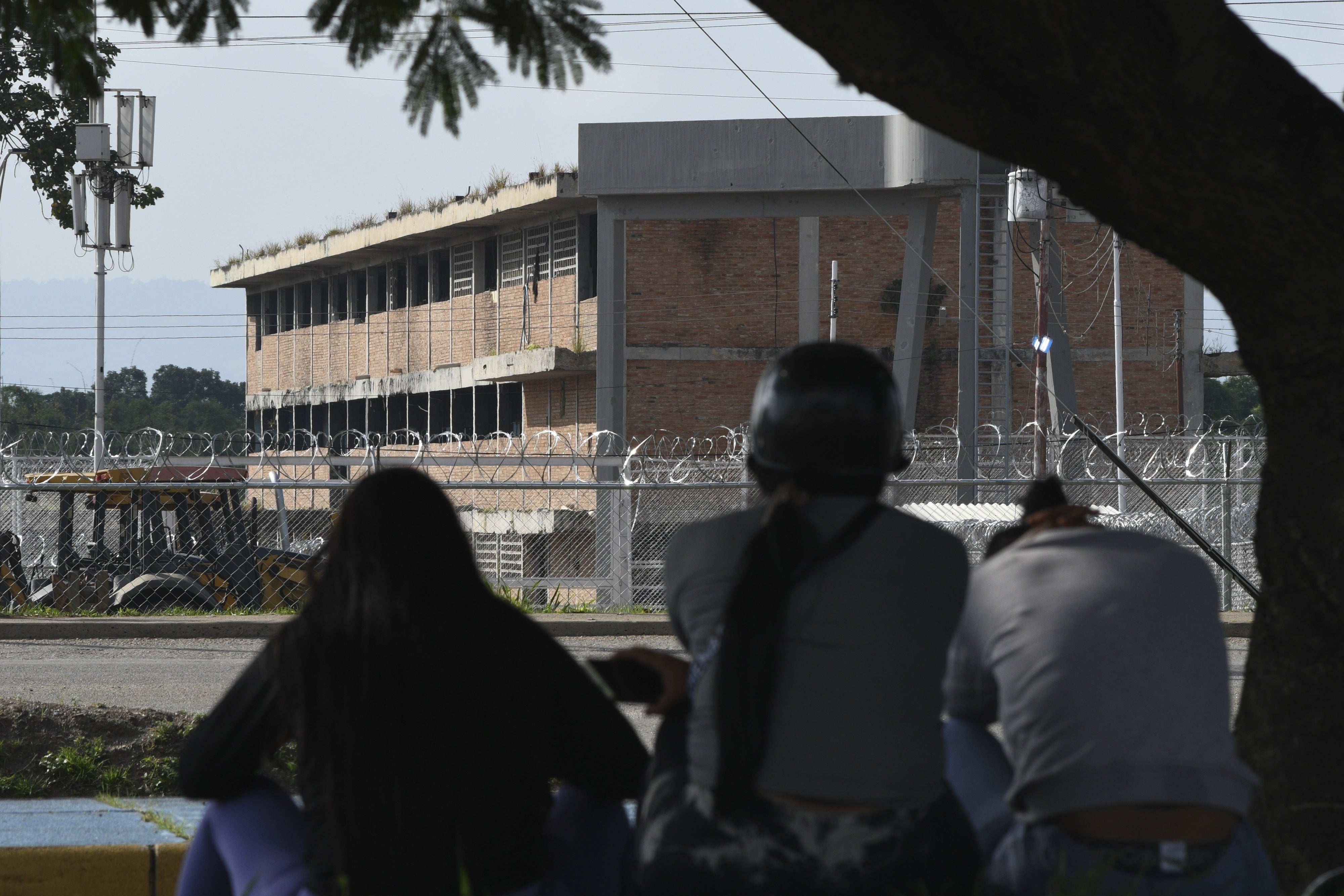
Many of the arrests occurred as part of what the government calls "Operation Knock Knock" (Operación Tun Tun). Venezuelan authorities have asked people to report on others who participate in protests or criticize the government. They have also encouraged Venezuelans to use government apps, like Ven App, to report on people. On July 31, Android and Apple app stores removed this app, but people who have downloaded them on their phones still have access to them.
Maduro and Attorney General Tarek Saab have said publicly that those arrested were responsible for violent events, terrorism, and other crimes. However, Human Rights Watch repeatedly found cases of people arrested for just criticizing the government or participating in peaceful protests.
Prosecutors have charged hundreds with sometimes broadly defined crimes carrying harsh sentences, such as "incitement to hatred," "resistance to authority," and "terrorism."
On the basis of interviews with local lawyers, human rights groups and others, Human Rights Watch has identified the following patterns in the arrests:
- Detainees are often kept in incommunicado detention, preventing contact with their families and lawyers, for weeks.
- Most detainees have been denied the right to be represented by a private lawyer of their choosing, even when they or their families explicitly request one.
- Judges and prosecutors have presented detainees at virtual hearings, often in groups. This poses significant problems for the fair administration of justice, making it hard for judges, prosecutors, and public defenders to adequately assess conditions or present evidence and arguments pertaining to each individual detainee.
Other Tools to Stifle Dissent
New Legislation Restricting Civic Space
On August 15, the government-controlled National Assembly approved the Law on Oversight, Regularization, Operations, and Financing of Non-Governmental Organizations and Non-Profit Social Organizations (Ley de Fiscalización, Regularización, Actuación y Financiamiento de las Organizaciones No Gubernamentales y Organizaciones Sociales Sin Fines de Lucro). Maduro has yet to sign it into law.
This law grants the government extensive control over the operation and financing of nongovernmental organizations, requiring all organizations operating in the country to register and submit detailed documents to the executive branch. The law's vague "prohibitions," "offenses," and established grounds to dissolve these groups severely undermine freedom of association. Additionally, the law's transitory provisions impose extremely short deadlines for compliance, threatening immediate cancellation for organizations unable to meet the requirements in time.
The National Assembly President Jorge Rodríguez said he wants the National Assembly to pass a law against "fascism," a term the Maduro government has used to described critics, including peaceful protesters.
Passport Cancellation
Since the July 28 election, Venezuelan authorities have canceled passports of critics, political leaders, and independent journalists, in what appear to be targeted efforts to punish critics and impede them from leaving the country. The authorities have also canceled passports of people already abroad.
Human Rights Watch received information about six cases - including journalists in Venezuela and abroad and their relatives - who learned from the website of the Administrative Service for Identification, Migration, and Foreigners (Servicio Administrativo de Identificación, Migración y Extranjería, SAIME), the government institution that issues passports, that their passports had been cancelled. The website did not indicate a reason.
On August 15, the Inter-American Commission on Human Rights reported 36 similar cases. The total number may be higher as several human rights defenders said that they preferred not to check the status of their passport on the website, fearing that authorities could see that as suspicious.






